seats Citroen JUMPY MULTISPACE 2013 2.G Owner's Guide
[x] Cancel search | Manufacturer: CITROEN, Model Year: 2013, Model line: JUMPY MULTISPACE, Model: Citroen JUMPY MULTISPACE 2013 2.GPages: 260, PDF Size: 8.79 MB
Page 88 of 260
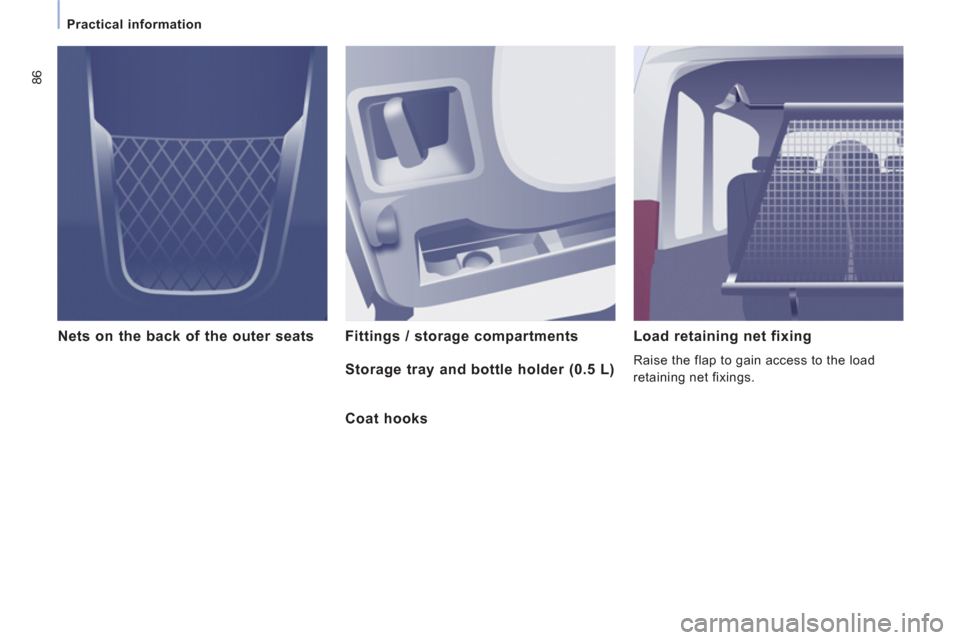
86
Practical information
Nets on the back of the outer seats Fittings / storage compartments
Load retaining net fixing
Raise the flap to gain access to the load
retaining net fixings. Storage tray and bottle holder (0.5 L)
Coat hooks
Page 94 of 260

92
Mirrors and windows
Manual rear view mirror
The rear view mirror has two positions:
- day (normal),
- night (anti-dazzle).
To change from one to the other, push or
pull the lever on the lower edge of the mirror.
SURVEILLANCE MIRROR
This mirror, placed on top of the central
mirror, enables the driver or front passenger
to observe all the rear seats.
Fitted on its own ball joint, it's manual
adjustment is simple and provides a view of
the rear interior of the vehicle.
It can also be adjusted for improved visibility
during manoeuvres or when overtaking.
REAR WINDOWS
2nd row side windows
If fitted on your vehicle, the 2nd row side
windows can be opened.
Squeeze the two controls then move the
window sideways. 4 notches are available.
While driving, the window must be closed or
secured on one of the 4 notches.
3rd row rear quarter lights
These are fixed.
Page 103 of 260
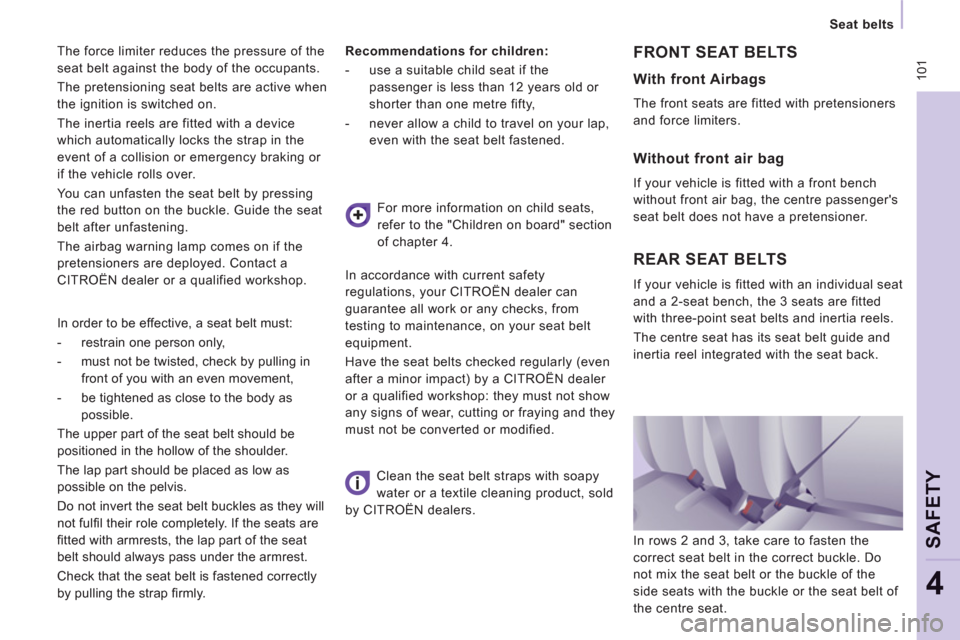
101
Seat belts
SAFETY
4
The force limiter reduces the pressure of the
seat belt against the body of the occupants.
The pretensioning seat belts are active when
the ignition is switched on.
The inertia reels are fitted with a device
which automatically locks the strap in the
event of a collision or emergency braking or
if the vehicle rolls over.
You can unfasten the seat belt by pressing
the red button on the buckle. Guide the seat
belt after unfastening.
The airbag warning lamp comes on if the
pretensioners are deployed. Contact a
CITROËN dealer or a qualified workshop.
Recommendations for children:
- use a suitable child seat if the
passenger is less than 12 years old or
shorter than one metre fifty,
- never allow a child to travel on your lap,
even with the seat belt fastened.
FRONT SEAT BELTS
REAR SEAT BELTS
If your vehicle is fitted with an individual seat
and a 2-seat bench, the 3 seats are fitted
with three-point seat belts and inertia reels.
The centre seat has its seat belt guide and
inertia reel integrated with the seat back. For more information on child seats,
refer to the "Children on board" section
of chapter 4.
In accordance with current safety
regulations, your CITROËN dealer can
guarantee all work or any checks, from
testing to maintenance, on your seat belt
equipment.
Have the seat belts checked regularly (even
after a minor impact) by a CITROËN dealer
or a qualified workshop: they must not show
any signs of wear, cutting or fraying and they
must not be converted or modified.
Clean the seat belt straps with soapy
water or a textile cleaning product, sold
by CITROËN dealers.
In order to be effective, a seat belt must:
- restrain one person only,
- must not be twisted, check by pulling in
front of you with an even movement,
- be tightened as close to the body as
possible.
The upper part of the seat belt should be
positioned in the hollow of the shoulder.
The lap part should be placed as low as
possible on the pelvis.
Do not invert the seat belt buckles as they will
not fulfi l their role completely. If the seats are
fi tted with armrests, the lap part of the seat
belt should always pass under the armrest.
Check that the seat belt is fastened correctly
by pulling the strap fi rmly.
With front Airbags
The front seats are fitted with pretensioners
and force limiters.
Without front air bag
If your vehicle is fitted with a front bench
without front air bag, the centre passenger's
seat belt does not have a pretensioner.
In rows 2 and 3, take care to fasten the
correct seat belt in the correct buckle. Do
not mix the seat belt or the buckle of the
side seats with the buckle or the seat belt of
the centre seat.
Page 105 of 260
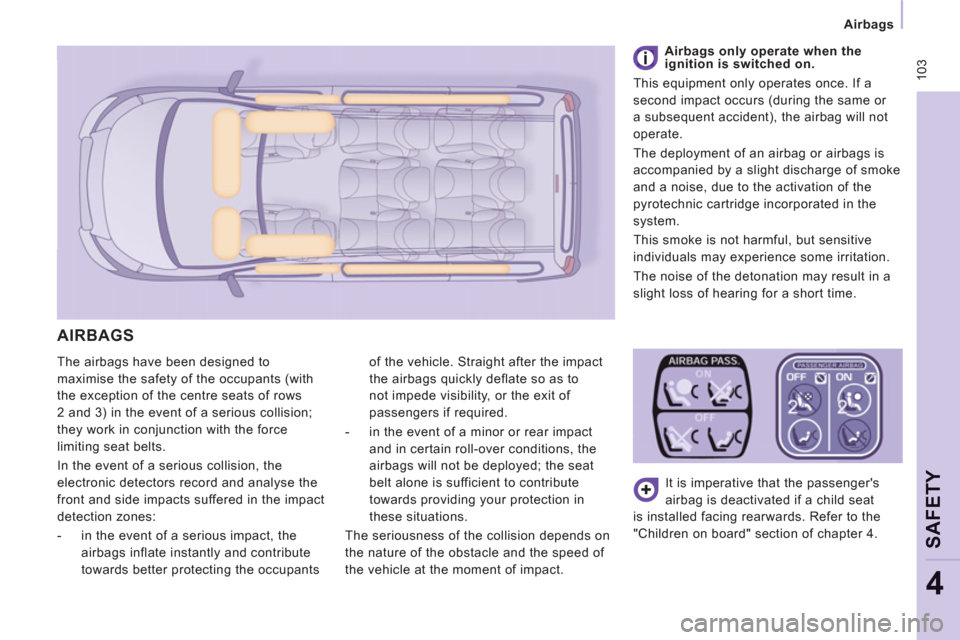
103
Airbags
SAFETY
4
The airbags have been designed to
maximise the safety of the occupants (with
the exception of the centre seats of rows
2 and 3) in the event of a serious collision;
they work in conjunction with the force
limiting seat belts.
In the event of a serious collision, the
electronic detectors record and analyse the
front and side impacts suffered in the impact
detection zones:
- in the event of a serious impact, the
airbags inflate instantly and contribute
towards better protecting the occupants of the vehicle. Straight after the impact
the airbags quickly deflate so as to
not impede visibility, or the exit of
passengers if required.
- in the event of a minor or rear impact
and in certain roll-over conditions, the
airbags will not be deployed; the seat
belt alone is sufficient to contribute
towards providing your protection in
these situations.
The seriousness of the collision depends on
the nature of the obstacle and the speed of
the vehicle at the moment of impact. It is imperative that the passenger's
airbag is deactivated if a child seat
is installed facing rearwards. Refer to the
"Children on board" section of chapter 4.
Airbags only operate when the
ignition is switched on.
This equipment only operates once. If a
second impact occurs (during the same or
a subsequent accident), the airbag will not
operate.
The deployment of an airbag or airbags is
accompanied by a slight discharge of smoke
and a noise, due to the activation of the
pyrotechnic cartridge incorporated in the
system.
This smoke is not harmful, but sensitive
individuals may experience some irritation.
The noise of the detonation may result in a
slight loss of hearing for a short time.
AIRBAGS
Page 106 of 260
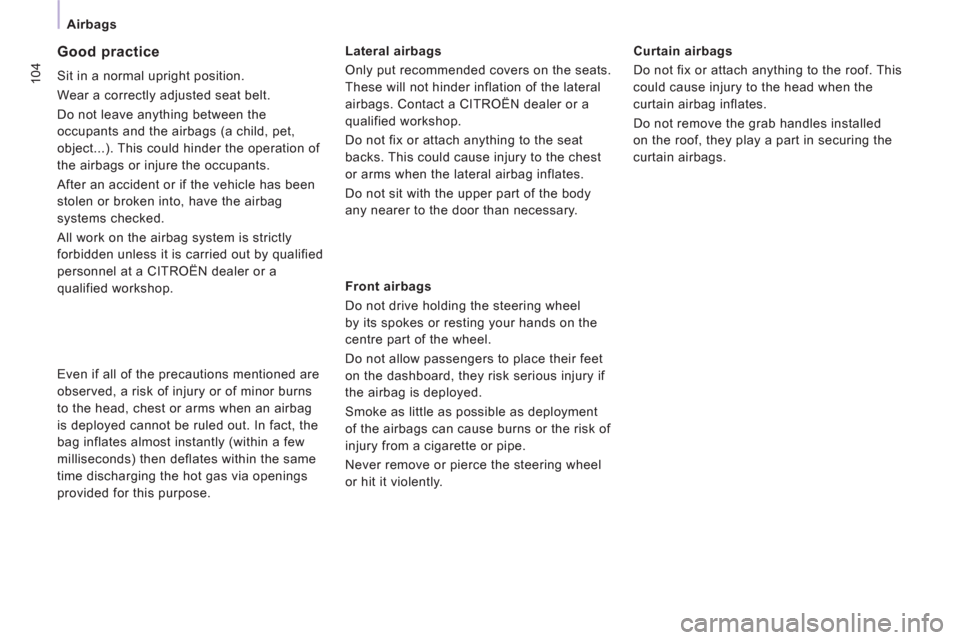
104
Airbags
Good practice
Sit in a normal upright position.
Wear a correctly adjusted seat belt.
Do not leave anything between the
occupants and the airbags (a child, pet,
object...). This could hinder the operation of
the airbags or injure the occupants.
After an accident or if the vehicle has been
stolen or broken into, have the airbag
systems checked.
All work on the airbag system is strictly
forbidden unless it is carried out by qualified
personnel at a CITROËN dealer or a
qualified workshop.
Lateral airbags
Only put recommended covers on the seats.
These will not hinder inflation of the lateral
airbags. Contact a CITROËN dealer or a
qualified workshop.
Do not fix or attach anything to the seat
backs. This could cause injury to the chest
or arms when the lateral airbag inflates.
Do not sit with the upper part of the body
any nearer to the door than necessary.
Front airbags
Do not drive holding the steering wheel
by its spokes or resting your hands on the
centre part of the wheel.
Do not allow passengers to place their feet
on the dashboard, they risk serious injury if
the airbag is deployed.
Smoke as little as possible as deployment
of the airbags can cause burns or the risk of
injury from a cigarette or pipe.
Never remove or pierce the steering wheel
or hit it violently.
Even if all of the precautions mentioned are
observed, a risk of injury or of minor burns
to the head, chest or arms when an airbag
is deployed cannot be ruled out. In fact, the
bag inflates almost instantly (within a few
milliseconds) then deflates within the same
time discharging the hot gas via openings
provided for this purpose.
Curtain airbags
Do not fix or attach anything to the roof. This
could cause injury to the head when the
curtain airbag inflates.
Do not remove the grab handles installed
on the roof, they play a part in securing the
curtain airbags.
Page 107 of 260

105
Airbags
SAFETY
4
Lateral airbags
If fitted on your vehicle, this is a system
which protects the driver and front
passenger in the event of a serious side
impact in order to limit the risk of injury to
the chest.
Each lateral airbag is fitted in the front seat
back frame, on the door side.
Impact detection zones
A.
Front impact zone.
B.
Side impact zone. If this warning lamp comes
on in the instrument panel,
accompanied by an audible signal
and a message in the screen,
contact a CITROËN dealer or a qualified
workshop to have the system checked. The
airbags may no longer be deployed in the
event of a serious impact.
Deployment
It is deployed unilaterally in the event of a
serious side impact applied to all or part
of the side impact zone B
, perpendicular
to the longitudinal centreline of the vehicle
on a horizontal plane and directed from the
outside towards the inside of the vehicle.
The lateral airbag inflates between the
front occupant of the vehicle and the
corresponding door trim panel.
Curtain airbags
This is a system which protects the driver
and passengers (with the exception of the
centre seats of rows 2 and 3) in the event of
a serious side impact in order to limit the risk
of head injuries.
Each curtain air bag is incorporated in the
pillars and the upper part of the passenger
compartment.
Deployment
It is deployed at the same time as the
corresponding lateral airbag in the event of
a serious side impact applied to all or part
of the side impact zone B
, perpendicular to
the longitudinal centreline of the vehicle on a
horizontal plane and directed from the outside
towards the inside of the vehicle.
The curtain airbag infl ates between the front or
rear occupant of the vehicle and the windows.
In the event of a minor impact or bump
on the side of the vehicle or if the
vehicle rolls over, the airbag may not be
deployed.
The airbag is not deployed in the event of a
rear or front collision.
Operating fault
Page 109 of 260
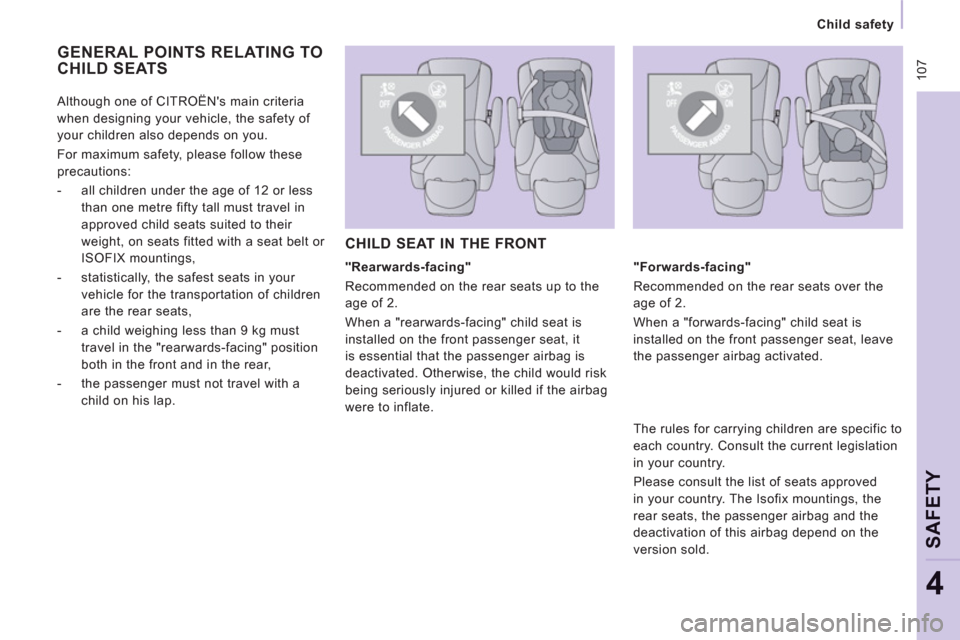
107
Child safety
SAFETY
4
GENERAL POINTS RELATING TO
CHILD SEATS
"Rearwards-facing"
Recommended on the rear seats up to the
age of 2.
When a "rearwards-facing" child seat is
installed on the front passenger seat, it
is essential that the passenger airbag is
deactivated. Otherwise, the child would risk
being seriously injured or killed if the airbag
were to inflate.
"Forwards-facing"
Recommended on the rear seats over the
age of 2.
When a "forwards-facing" child seat is
installed on the front passenger seat, leave
the passenger airbag activated.
CHILD SEAT IN THE FRONT
The rules for carrying children are specific to
each country. Consult the current legislation
in your country.
Please consult the list of seats approved
in your country. The Isofix mountings, the
rear seats, the passenger airbag and the
deactivation of this airbag depend on the
version sold.
Although one of CITROËN's main criteria
when designing your vehicle, the safety of
your children also depends on you.
For maximum safety, please follow these
precautions:
- all children under the age of 12 or less
than one metre fifty tall must travel in
approved child seats suited to their
weight, on seats fitted with a seat belt or
ISOFIX mountings,
- statistically, the safest seats in your
vehicle for the transportation of children
are the rear seats,
- a child weighing less than 9 kg must
travel in the "rearwards-facing" position
both in the front and in the rear,
- the passenger must not travel with a
child on his lap.
Page 110 of 260
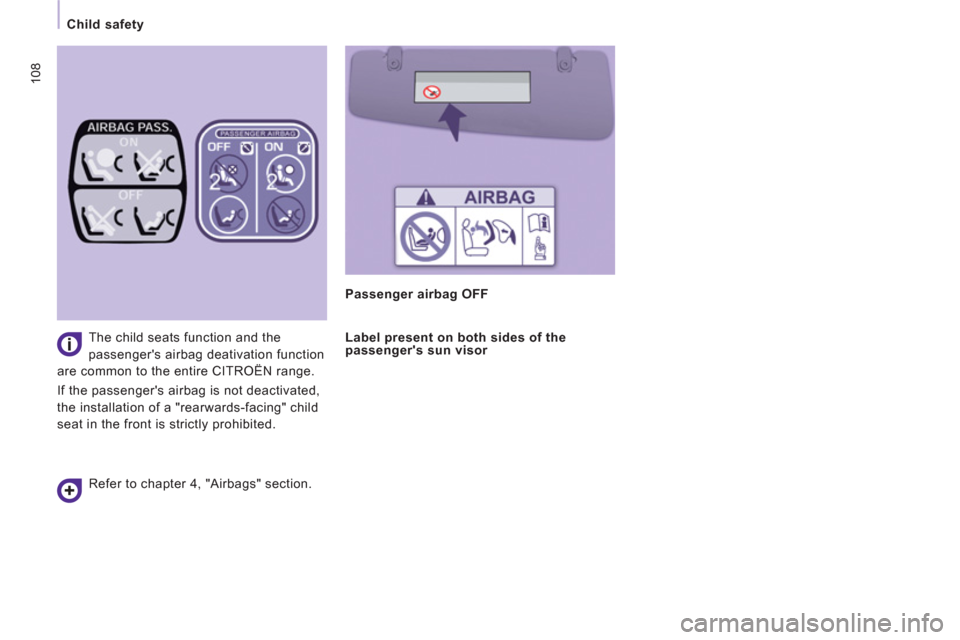
108
Child safety
The child seats function and the
passenger's airbag deativation function
are common to the entire CITROËN range.
If the passenger's airbag is not deactivated,
the installation of a "rearwards-facing" child
seat in the front is strictly prohibited.
Refer to chapter 4, "Airbags" section.
Passenger airbag OFF
Label present on both sides of the
passenger's sun visor
Page 113 of 260
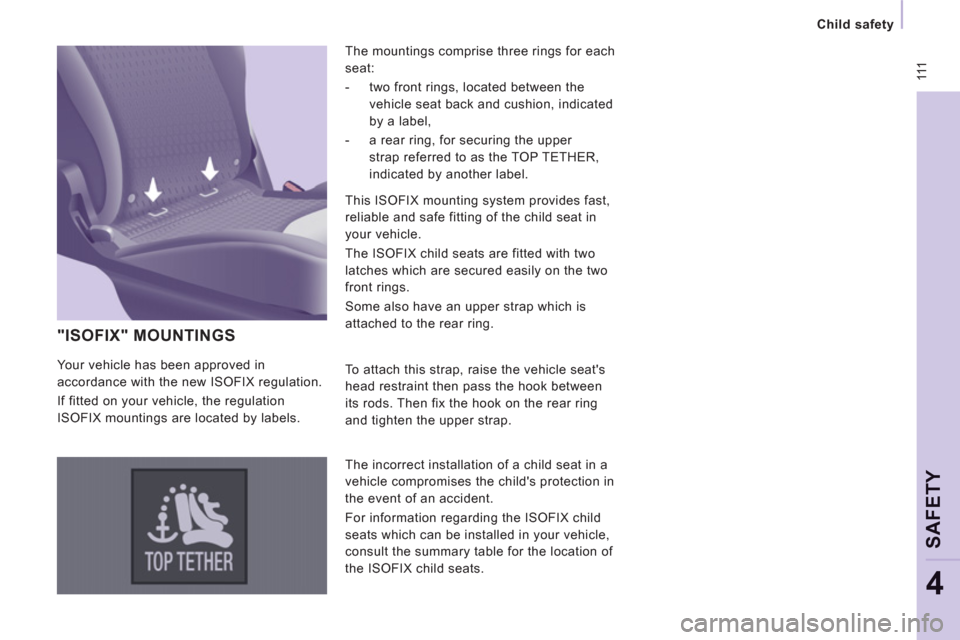
111
Child safety
SAFETY
4
"ISOFIX" MOUNTINGS
The mountings comprise three rings for each
seat:
- two front rings, located between the
vehicle seat back and cushion, indicated
by a label,
- a rear ring, for securing the upper
strap referred to as the TOP TETHER,
indicated by another label.
Your vehicle has been approved in
accordance with the new ISOFIX regulation.
If fitted on your vehicle, the regulation
ISOFIX mountings are located by labels. This ISOFIX mounting system provides fast,
reliable and safe fitting of the child seat in
your vehicle.
The ISOFIX child seats are fitted with two
latches which are secured easily on the two
front rings.
Some also have an upper strap which is
attached to the rear ring.
To attach this strap, raise the vehicle seat's
head restraint then pass the hook between
its rods. Then fix the hook on the rear ring
and tighten the upper strap.
The incorrect installation of a child seat in a
vehicle compromises the child's protection in
the event of an accident.
For information regarding the ISOFIX child
seats which can be installed in your vehicle,
consult the summary table for the location of
the ISOFIX child seats.
Page 114 of 260
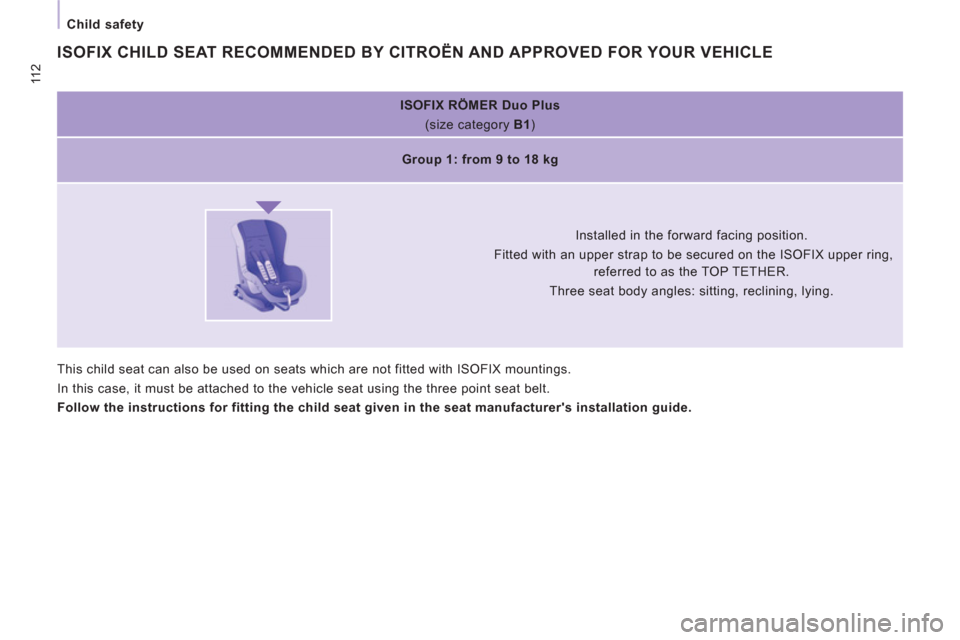
11 2
Child safety
ISOFIX
RÖMER Duo Plus
(size category B1
)
Group 1: from 9 to 18 kg
Installed in the forward facing position.
Fitted with an upper strap to be secured on the ISOFIX upper ring,
referred to as the TOP TETHER.
Three seat body angles: sitting, reclining, lying.
This child seat can also be used on seats which are not fitted with ISOFIX mountings.
In this case, it must be attached to the vehicle seat using the three point seat belt.
Follow the instructions for fitting the child seat given in the seat manufacturer's installation guide.
ISOFIX CHILD SEAT RECOMMENDED BY CITROËN AND APPROVED FOR YOUR VEHICLE